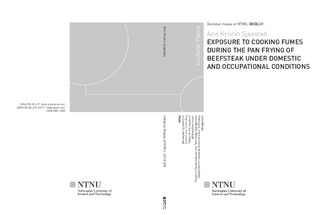| dc.contributor.advisor | Svendsen, Kristin | nb_NO |
| dc.contributor.author | Sjaastad, Ann Kristin | nb_NO |
| dc.date.accessioned | 2014-12-19T14:27:20Z | |
| dc.date.available | 2014-12-19T14:27:20Z | |
| dc.date.created | 2011-01-07 | nb_NO |
| dc.date.issued | 2010 | nb_NO |
| dc.identifier | 384042 | nb_NO |
| dc.identifier.isbn | 978-82-471-2445-1 | nb_NO |
| dc.identifier.uri | http://hdl.handle.net/11250/265792 | |
| dc.description.abstract | Possible connections have been shown between exposure to cooking fumes and adverse health effects, such as lung cancer, rhinitis and reduced lung function. The aim of this study was to monitor the personal exposure to some of the harmful components of cooking fumes during the frying of beefsteak under experimental conditions resembling both domestic and occupational cooking situations, and during real-life occupational cooking. In addition, the aim was to investigate the occurrence of the same components during a variety of frying procedures, i.e. with different frying fats, cooking appliances and kitchen exhaust hoods. The spreading of cooking fumes in the kitchen and neighbouring rooms in private homes was also explored.
In a custom-built laboratory kitchen, standardized experiments were performed under conditions similar to the frying of beefsteak in real-life domestic and occupational conditions. Personal sampling was conducted of total particles, high molecular weight aldehydes, polycyclic aromatic hydrocarbons (PAHs) and ultrafine particles. In addition, stationary measurements of ultrafine and submicrometer particles were performed in the kitchen and in the neighbouring room. Tests were conducted under the use of different frying fats (margarine, soya bean oil, rapeseed oil, olive oil), different types (4 types) and settings (2 levels) of kitchen exhaust hoods and different cooking appliances (gas, electric). In addition, personal sampling of total particles, high molecular weight aldehydes and polycyclic aromatic hydrocarbons was conducted in three restaurant kitchens.
The studies confirmed the presence of carcinogenic components (higher aldehydes and PAHs) in fumes from Norwegian cooking styles which were collected in the breathing zone of the cook. It was also shown that the fumes spread to neighbouring rooms, and that leaving the kitchen extraction hood on for 30 minutes after the end of frying reduced the spreading significantly. The use of different types and settings of kitchen extraction hoods resulted in different exposure conditions. The choice of frying fat also seemed to affect the concentrations of particulate matter and chemical components produced during the frying of beefsteak, but the studies were not comprehensive enough to recommend preferable fats. In addition, the results indicated that frying on a gas stove caused a higher exposure to some of the hazardous components in cooking fumes than frying on an electric stove.
Furthermore, the results suggested that cooking under experimental conditions may give a correct reflection of occupational exposure conditions if numerous repetitions of a very specific and standardized cooking method are performed. The level of total particles and the level of PAHs and higher aldehydes did not covariate, suggesting that the measured levels of particulate matter alone are unsuitable as indicators of the actual health risk inflicted upon persons exposed to cooking fumes.
It seems vital to reduce the exposure to cooking fumes as far as possible. In the area of extraction hoods, more research is needed in order to develop optimal systems. Additional studies are required in order to be able to identify relations between exposure to and adverse effects of cooking fumes. | nb_NO |
| dc.language | eng | nb_NO |
| dc.publisher | NTNU | nb_NO |
| dc.relation.ispartofseries | Doctoral Theses at NTNU, 1503-8181; 2010:228 | nb_NO |
| dc.relation.haspart | Sjaastad, Ann Kristin; Svendsen, Kristin. Exposure to Mutagenic Aldehydes and Particulate Matter During Panfrying of Beefsteak with Margarine, Rapeseed Oil, Olive Oil or Soybean Oil. Annals of Occupational Hygiene. (ISSN 0003-4878). 52(8): 739-745, 2008. <a href='http://dx.doi.org/10.1093/annhyg/men060'>10.1093/annhyg/men060</a>. | nb_NO |
| dc.relation.haspart | Sjaastad, Ann Kristin; Svendsen, Kristin. Different Types and Settings of Kitchen Canopy Hoods and Particulate Exposure Conditions during Pan-frying of Beefsteak. Indoor + Built Environment. (ISSN 1420-326X). 19(2): 267-274, 2010. <a href='http://dx.doi.org/10.1177/1420326X09347426'>10.1177/1420326X09347426</a>. | nb_NO |
| dc.relation.haspart | Sjaastad, Ann Kristin; Jorgensen, Rikke Bramming; Svendsen, Kristin. Exposure to polycyclic aromatic hydrocarbons (PAHs), mutagenic aldehydes and particulate matter during pan frying of beefsteak. Occupational and Environmental Medicine. (ISSN 1351-0711). 67(4): 228-232, 2010. <a href='http://dx.doi.org/10.1136/oem.2009.046144'>10.1136/oem.2009.046144</a>. | nb_NO |
| dc.relation.haspart | Sjaastad, Ann Kristin; Svendsen, Kristin. Exposure to Polycyclic Aromatic Hydrocarbons (PAHs), Mutagenic Aldehydes, and Particulate Matter in Norwegian a la Carte Restaurants. Annals of Occupational Hygiene. (ISSN 0003-4878). 53(7): 723-729, 2009. <a href='http://dx.doi.org/10.1093/annhyg/mep059'>10.1093/annhyg/mep059</a>. | nb_NO |
| dc.title | Exposure to cooking fumes during the pan frying of beefsteak under domestic and occupational conditions | nb_NO |
| dc.type | Doctoral thesis | nb_NO |
| dc.source.pagenumber | 125 | nb_NO |
| dc.contributor.department | Norges teknisk-naturvitenskapelige universitet, Fakultet for samfunnsvitenskap og teknologiledelse, Institutt for industriell økonomi og teknologiledelse | nb_NO |
| dc.description.degree | Dr.philos. | nb_NO |
| dc.description.degree | Dr.philos. | en_GB |


